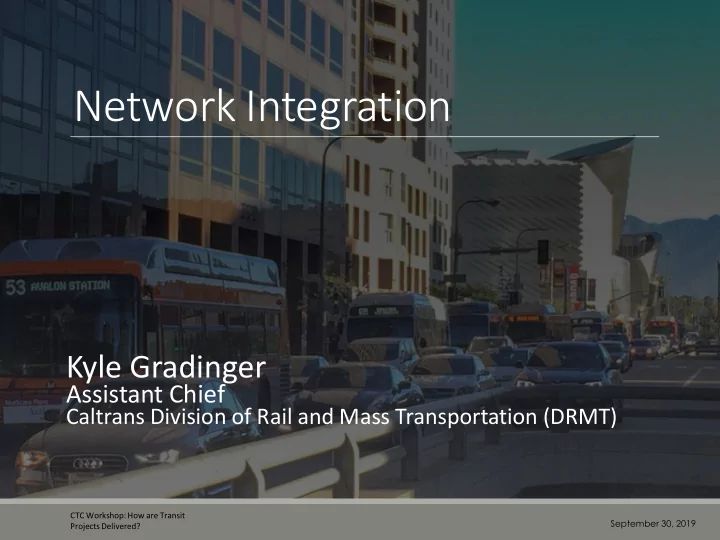

Network Integration Kyle Gradinger Assistant Chief Caltrans Division of Rail and Mass Transportation (DRMT) CTC Workshop: How are Transit September 30, 2019 Projects Delivered?
What is Network Integration?
FOR USERS , NETWORK What is INTEGRATION FUNDAMENTALLY MEANS CREATING A SEAMLESS Network TRAVEL EXPERIENCE ACROSS RAIL Integration? AND TRANSIT IN CALIFORNIA BY ELIMINATING POINTS OF FRICTION .
Poor service design and lack of coordination across agencies
Inadequate and inaccurate trip-planning ? information
Unclear fare structure and payments Incompatible fare and ticketing policies between agencies require passengers to purchase multiple tickets for one journey.
Poor Physical Connections between travel modes, such as stations that require long walks and lack travel amenities.
The Current Situation: Disconnected Transit
The Future Situation: Integrated Transit
A Real-World Example
Wetzikon, Switzerland
Wetzikon CTC Workshop: How are Transit September 30, 2019 Projects Delivered?
Integrated Planning Approach • Service Planning DRMT encourages coordinated statewide investments based on service goals • Strike a balance between service, infrastructure, and rolling stock needs • Crucial to make targeted investments that meet near term goals without precluding long term vision. Rolling Stock Infrastructure Requirements Requirements
Wetzikon Zürich 1. Buses arrive in advance of the trains S14 S 5 2. Trains arrive in the station 3. All services are in the station Buses 4. Trains depart from the station 5. Buses depart from the station 5 4 3 2 1 CTC Workshop: How are Transit September 30, 2019 Projects Delivered?
FOR THE STATE AND OUR PARTNERS , NETWORK INTEGRATION MEANS: • COLLABORATING TO ELIMINATE What is DUPLICATE INVESTMENTS; Network • PLANNING OF SHARED CORRIDORS AND INFRASTRUCTURE; Integration? • COORDINATED SCHEDULES; • COORDINATING ROLLING STOCK PROCUREMENT AND MANAGEMENT.
Why Network Integration?
The California State Rail Plan and the forthcoming 2040 Vision for Statewide Transit Strategic Passenger Rail Plan describe the need to coordinate investments in a way that ties together public transit offerings across California into a cohesive system. » Integrated Statewide Network » High Speed Rail » Intercity and Regional Services » Integrated Express Bus » Coordinated Schedules » Regular pulsed service » Key transfer hubs » Public Transit Connections » Customer Focus » Seamless First/Last-Mile Access » Integrated Ticketing » Auto and air competitive
Rail Plan Vision: Ridership » Results show incremental increase in rail ridership due to population growth » However, market potential for networked services is unrealized County to County Draw Loads
Rail Plan Vision: Ridership – Market Potential » Result of integration and HSR shows huge increase in rail ridership demand » Satisfies a large market potential for networked services County-to- County Draw Loads
California’s statewide goals necessitate integration of our transportation system for: • Climate change goals • Mode shift goals • Equity goals
Through network effects, economies of scale , simplification, and the adoption of uniform standards and practices, we can realize greater benefits: • Reduced costs to operate public transportation • Reduced cost for travelers to use public transportation • Increased ridership • Increased farebox recovery and revenue
Network Integration & TIRCP
Network integration is one of the 4 main policy objectives of the TIRCP program. The guidelines for “Projects eligible for funding under TIRCP the upcoming cycle include... Rail, bus, and ferry integration implementation, including integrated ticketing clarifies and makes and scheduling systems, shared-use corridors, explicit the related planning efforts, and other service expectation when integration initiatives.” applying for network - CA PRC 75221(a)(3) integration projects.
• The State is invested in the continued development of a comprehensive, integrated network. • 18 agencies in 2018 were awarded network integration funds to multiply the benefits of the standalone investments.
Examples of funded network integration projects include: • Design enhancements to improve ease of transfers from different systems • Review and support for development of integrated, pulse- schedule service plans for corridors • Development of a feasibility study analyzing potential for new service • Identifying best practices for integrating regional transit and rail services, including: scheduling; fare; governance; operations.
Caltrans has a statutory responsibility (AB 528) for interregional transit planning and coordination. The State serves as a coordinator for planning, funding and technology decisions with system- wide impacts. We rely on local agencies to know what’s best for their region.
Cal-ITP: Eliminating Trip- Planning and Payment Barriers
California I Integ egrated T Travel el Projec ect ( t (Cal al-ITP) TP) • Increase ridership by offering seamless trip planning/payment across modes and across California • Making transit easier for the transit rider by enabling a great user experience • Meet changing consumer expectations • Lower costs of fare/revenue collection/information management due to advantage of economies of scale
What Can We Integrate? TRANSACTION PHASE TRIP PLANNING PHASE Mobility Payment Service Systems Data Each journey phase is enabled and improved by a series of processes and technologies. Wayfinding Customer JOURNEY PHASE Service & Feedback POST-JOURNEY PHASE
What Can We Integrate? Contracts & Procurements Policies & Regulations The People » Mobility Operations Service » Service Data » Wayfinding Vehicles » Infrastructure » Payment Systems …are the NETWORK Customer Service & Feedback User Data/ Accounts/ These other 7 components should be integrated Identity
Moving CA Forward
The shift to Zero-Emissions Buses (ZEBs) will require an integrated planning approach that must consider the tradeoffs between service design, vehicle technology, and infrastructure. Working with multiple state agencies and transit agencies, we can meet our policy goals and make California a global leader in the field of ZEBs.
Questions?
Recommend
More recommend